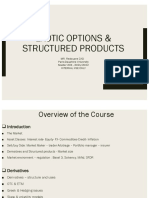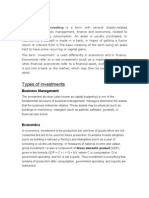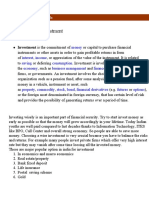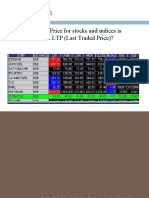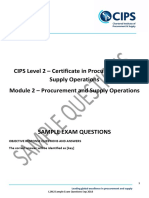Classification of Assets: Leave A Reply
Classification of Assets: Leave A Reply
Uploaded by
Shinam JainCopyright:
Available Formats
Classification of Assets: Leave A Reply
Classification of Assets: Leave A Reply
Uploaded by
Shinam JainOriginal Title
Copyright
Available Formats
Share this document
Did you find this document useful?
Is this content inappropriate?
Copyright:
Available Formats
Classification of Assets: Leave A Reply
Classification of Assets: Leave A Reply
Uploaded by
Shinam JainCopyright:
Available Formats
theintactone !
MENU
Read MBA, BBA, B.COM Notes
Classification of Assets
Assets
Mostly assets are classified based on 3 broad
categories:
Traditional assets
The “traditional” asset classes are stocks, bonds,
and cash:
Stocks: value, dividend, growth, or sector-
specific (or a “blend” of any two or more
of the preceding); large-cap versus mid-
cap, small-cap or micro-cap; domestic,
foreign (developed), emerging or frontier
markets
Bonds (fixed income securities more
generally): investment-grade or junk
(high-yield); government or corporate;
short-term, intermediate, long-term;
domestic, foreign, emerging markets
Cash and cash equivalents (e.g., deposit
account, money market fund)
Depending on their
extent of convertibility,
Convertibility they are further divided
into fixed assets or
current assets.
Comprise assets that
Physical
are both tangible and
existence
intangible.
Depending on their
purpose of use, they
Purpose are categorised as
operating and non-
operating assets.
The following offers a fair idea about the different
types of assets in general:
Current assets or short-term assets
These types of assets can be readily converted into
cash or its equivalent resources typically within a
year and are known as liquid assets. For example,
cash equivalents, stock, marketable securities and
short-term deposits are some of the most common
current assets.
Fixed assets or long-term assets
Also known as hard assets and fixed assets, these
resources are not easy to convert into cash or its
equivalent kind. Generally, land, machinery,
equipment, building, patents, trademarks, etc. are
considered as fixed assets.
Tangible assets
Similarly, assets with a physical existence are
categorised as tangible assets. Resources like
stock, land, building, office supplies, equipment,
machinery and marketable securities, among others
are functioning examples of tangible assets.
Intangible assets
On the contrary, assets which do not possess a
physical existence come under the category of
intangible assets. The best examples of such
assets would be market goodwill, corporate
intellectual property, patents, copyrights, permits,
trade secrets, brand, etc.
Operating assets
Assets like cash, building, machinery, equipment,
copyright, goodwill, stock, etc. are termed as
operating assets. Typically, such assets are used to
generate revenue and to maintain daily operation.
Non-operating assets
Though these assets are not used for performing
daily operations, they tend to help generate
significant revenue. Some of the best examples of
non-operating assets are short-term investments,
vacant land, income generated through fixed
deposits, etc.
Alternative assets
Other alternative assets that may be considered
include:
Commodities: precious metals,
nonferrous metals, agriculture, energy,
others.
Commercial or residential real estate
(also REITs)
Collectibles such as art, coins, or stamps
Insurance products (annuity, life
settlements, catastrophe bonds, personal
life insurance products, etc.)
Derivatives such as options, collateralized
debt, and futures
Foreign currency
Venture capital
Private equity
Distressed securities
Infrastructure
Hedge funds
Share this:
! Twitter " Facebook # Telegram
$ WhatsApp % Email & LinkedIn
' Reddit ( Tumblr ) Pinterest * Pocket
+ Skype
Like this:
Loading...
Related
Guru Gobind Singh Dr. APJ Abdul Kalam
Indraprastha Technical University
University (MBA) MBA Notes (KMBN,
Notes KMB & RMB Series
Read MBA Syllabus Notes)
wise notes of Read MBA Syllabus
GGSIPU,New Delhi wise notes of
20 Dec 2018 AKTU,LUCKNOW
In "GGSIPU MBA 8 Dec 2018
NOTES" In "AKTU MBA NOTES"
Guru Gobind Singh
Indraprastha
University (BBA) Notes
Read BBA Syllabus
wise notes of
GGSIPU,New Delhi
9 Feb 2019
In "GGSIPU BBA
NOTES"
PREVIOUS POST NEXT POST
Risk returns Asset Allocation:
characteristics of Guidelines for
assets asset Allocation
YOU MIGHT ALSO LIKE
Financing of Small Scale Industries in
Developing Countries
! 21 Mar 2019
WTO and Environment Protection
! 25 Mar 2020
Meaning and concept of Production
! 27 Jun 2019
Leave a Reply
Enter your comment here...
Enter your comment here...
!"#$%&'()*+,)-"#$%&'()./)0+1'+&.2$
(*+*3'('+&
!"#$"%&'()*"+
,*(*-.$
/*"*0$1$"%
23"4%5&"6)&7
!"%$'1$+5*'5$6
/$*"5"0)&7
5"#$"%&'(8)9(:$6)&7
5"#$"%&'(
9(:$6)&7);</=>
?5$'*'4@54*.
+*%*-*6$6
A*6@)/*"*0$1$"%
/&+$.6
Search … SEARCH
CHANGE LANGUAGE
Select Language
Powered by Translate
Copyright ©theintactone Powered by and Bam.
You might also like
- Efas Ifas SfasDocument4 pagesEfas Ifas Sfasعبدالرحمن القطاونة100% (1)
- Calgene Case AnalysisDocument2 pagesCalgene Case AnalysisArjun JoshiNo ratings yet
- Module 3 Activity Case StudyDocument2 pagesModule 3 Activity Case Studychuushu100% (1)
- Chapter 11 - Answers To Concept QuestionsDocument9 pagesChapter 11 - Answers To Concept QuestionsMsKhan0078No ratings yet
- Financial StrategyDocument12 pagesFinancial StrategyLakshay KalraNo ratings yet
- Porter Five Forces AnalysisDocument3 pagesPorter Five Forces AnalysisMahabub Haider100% (1)
- Investment Planning (Asset Allocation - Concepts & Practices)Document40 pagesInvestment Planning (Asset Allocation - Concepts & Practices)mkpatidarNo ratings yet
- Decoding Investment Advice 1692778055Document4 pagesDecoding Investment Advice 1692778055sache vilayetiNo ratings yet
- Unit 2Document6 pagesUnit 2malarastogi611No ratings yet
- PRP DE en IE00B53SZB19 YES 2024-04-19Document3 pagesPRP DE en IE00B53SZB19 YES 2024-04-19naqwn88No ratings yet
- F446 Chapter 1 Student Handout (8 Edition)Document7 pagesF446 Chapter 1 Student Handout (8 Edition)Juncheng WuNo ratings yet
- Chapter-1 Investment Scenario Genesis and GrowthDocument11 pagesChapter-1 Investment Scenario Genesis and GrowthaswinecebeNo ratings yet
- Makalah Tentang Asset (Bahasa Inggris)Document5 pagesMakalah Tentang Asset (Bahasa Inggris)Ilham Sukron100% (1)
- GROUP 1 - Financial MarketDocument20 pagesGROUP 1 - Financial MarketivandimaunahannnNo ratings yet
- Project Report OnDocument79 pagesProject Report OnKuladeepa KrNo ratings yet
- Investors GuideDocument12 pagesInvestors GuideBabar JunaidNo ratings yet
- Peter Goa - English Exercise Unit 4Document14 pagesPeter Goa - English Exercise Unit 4Ronaldo Stevent SitohangNo ratings yet
- Ie00b4nd3602 - Igln - Uk 9ae5168cefDocument3 pagesIe00b4nd3602 - Igln - Uk 9ae5168cefbetka.copakovaNo ratings yet
- NSE's Certification in Financial MarketDocument23 pagesNSE's Certification in Financial MarketHesham HeshamNo ratings yet
- 3.1.2 Types of Investment Products 3Document16 pages3.1.2 Types of Investment Products 3UjjwxlNo ratings yet
- Nature & Scope of Invt MGMTDocument65 pagesNature & Scope of Invt MGMTAishwarya ChoodamaniNo ratings yet
- Mutual FundsDocument10 pagesMutual FundsSidharth SidduNo ratings yet
- A Study On Investors' Attitude Towards Mutual Funds As An Investment OptionDocument10 pagesA Study On Investors' Attitude Towards Mutual Funds As An Investment OptionPankaj PatilNo ratings yet
- Alternative Investments - Zell Education 2024Document52 pagesAlternative Investments - Zell Education 2024harshNo ratings yet
- Y Y Y Y Y: by K.Madhusoothanan VMM 6ooDocument20 pagesY Y Y Y Y: by K.Madhusoothanan VMM 6ooJana DxNo ratings yet
- Canadian Securities: The Capital MarketsDocument47 pagesCanadian Securities: The Capital MarketsNikku SinghNo ratings yet
- 2015 ProjectDocument76 pages2015 ProjectVaibhavRanjankarNo ratings yet
- A Study and Understanding of The Investment Environment Would Be of Importance To The InvestorDocument25 pagesA Study and Understanding of The Investment Environment Would Be of Importance To The InvestorSewale AbateNo ratings yet
- IE00B3WJKG14Document3 pagesIE00B3WJKG14eneru.download98No ratings yet
- Final Exam Financing Organizations Assignment 1: Banking Academy of Vietnam International School of BusinessDocument8 pagesFinal Exam Financing Organizations Assignment 1: Banking Academy of Vietnam International School of BusinessViệt Tùng NguyễnNo ratings yet
- Chapter - 3 Investment Avenues: "A Study On Investment Pattern Amongst Academicians in Bangalore"Document28 pagesChapter - 3 Investment Avenues: "A Study On Investment Pattern Amongst Academicians in Bangalore"SHAHIDNo ratings yet
- Visa Solana - The Relentless Rise of StablecoinsDocument40 pagesVisa Solana - The Relentless Rise of StablecoinscombassoNo ratings yet
- PG - M.B.a Financial Management - English - 357 44 Investment and Derivatives Market - 2652Document238 pagesPG - M.B.a Financial Management - English - 357 44 Investment and Derivatives Market - 2652Yash AgarwalNo ratings yet
- Understanding Structured ProductsDocument4 pagesUnderstanding Structured ProductsKofikoduahNo ratings yet
- Article-Beyond Stocks and Bonds-A True Alt InvestmentDocument2 pagesArticle-Beyond Stocks and Bonds-A True Alt InvestmentBruce GreigNo ratings yet
- The Financial Environment: Markets, Institutions & Intrest RatesDocument34 pagesThe Financial Environment: Markets, Institutions & Intrest Ratesnumlit1984No ratings yet
- REITs Chapter 1 RevisedDocument8 pagesREITs Chapter 1 RevisedliezelvonnecaballeroNo ratings yet
- A Research Study On Investors Behaviour Regarding Choice of Asset Allocation of Teaching StaffDocument10 pagesA Research Study On Investors Behaviour Regarding Choice of Asset Allocation of Teaching StaffresearchparksNo ratings yet
- Stocks Bonds Money Market Securities Fund Manager TradesDocument13 pagesStocks Bonds Money Market Securities Fund Manager TradesarobindohalderNo ratings yet
- NISM Series V-A MFD Certification Exam - Aug 2023 Re (21-30)Document10 pagesNISM Series V-A MFD Certification Exam - Aug 2023 Re (21-30)yashgarg21101No ratings yet
- 1 - Introduction - Derivatives GreeksDocument50 pages1 - Introduction - Derivatives GreeksThomas GallantNo ratings yet
- Mutual Funds FaqDocument9 pagesMutual Funds Faqgopi_ggg20016099No ratings yet
- Economics 122: Financial Economi Cs (Lecture 1) M. Debuque - G Onz Ales AY2014 - 201 5Document24 pagesEconomics 122: Financial Economi Cs (Lecture 1) M. Debuque - G Onz Ales AY2014 - 201 5cihtanbioNo ratings yet
- Investment: Types of InvestmentsDocument20 pagesInvestment: Types of InvestmentsAtul YadavNo ratings yet
- Investment IntroductionDocument61 pagesInvestment IntroductiontadegebreyesusNo ratings yet
- CSE Awareness On Savings and Investment For The StudentsDocument33 pagesCSE Awareness On Savings and Investment For The StudentsAlexander FloresNo ratings yet
- Hayah BSF ModerateDocument4 pagesHayah BSF ModeratechloewalkerhrNo ratings yet
- Steven Romick September 30, 2010Document13 pagesSteven Romick September 30, 2010eric695No ratings yet
- LR of Stock MarketDocument2 pagesLR of Stock MarketBnaren NarenNo ratings yet
- Investment PhilosophyDocument5 pagesInvestment PhilosophyDan KumagaiNo ratings yet
- AltInv Lecture 1 Intro To Alternative Investments 4in1Document4 pagesAltInv Lecture 1 Intro To Alternative Investments 4in1mohammad.baboo4No ratings yet
- An Introduction To Structured ProductsDocument3 pagesAn Introduction To Structured ProductsAvikant Bhardwaj100% (1)
- Diversification Through Commodity Mutual FundsDocument4 pagesDiversification Through Commodity Mutual FundsSrishti YadavNo ratings yet
- Project MF - Kuldeep SinghDocument73 pagesProject MF - Kuldeep SinghJoanna HernandezNo ratings yet
- Indian Investment TrendsDocument49 pagesIndian Investment TrendsRamesh AgarwalNo ratings yet
- Perfomence Evalution of Public and Private Sector Mutual FundsDocument81 pagesPerfomence Evalution of Public and Private Sector Mutual FundssaiyuvatechNo ratings yet
- Topic 1 Investments: An IntroductionDocument51 pagesTopic 1 Investments: An Introductionqian liuNo ratings yet
- Lecture 1 (Introduction To Security Analysis)Document44 pagesLecture 1 (Introduction To Security Analysis)Devyansh GuptaNo ratings yet
- Cornerstone Houston CESITDocument13 pagesCornerstone Houston CESITlarrysmNo ratings yet
- Unit 1. Nature and Scope of Investment and Portfolio ManagementDocument7 pagesUnit 1. Nature and Scope of Investment and Portfolio ManagementCLIVE100% (1)
- Isa 2020 Chapter3Document13 pagesIsa 2020 Chapter3martina MegaNo ratings yet
- Proposal: Analysis of The Preference Level of Investors in Mutual Fund in AhmedabadDocument19 pagesProposal: Analysis of The Preference Level of Investors in Mutual Fund in AhmedabadAshutosh MishraNo ratings yet
- A Fighting Chance: The High School Finance Education Everyone DeservesFrom EverandA Fighting Chance: The High School Finance Education Everyone DeservesNo ratings yet
- Retirement Planning ProcessDocument1 pageRetirement Planning ProcessShinam JainNo ratings yet
- Set Off and Carry Forward of LossesDocument1 pageSet Off and Carry Forward of LossesShinam JainNo ratings yet
- MANAGEMENT AND CORPORATE FINANCE (Final)Document95 pagesMANAGEMENT AND CORPORATE FINANCE (Final)Shinam Jain100% (1)
- Prachi Raj ResumeDocument1 pagePrachi Raj ResumeShinam JainNo ratings yet
- Misfit t200Document1 pageMisfit t200entertainment kingNo ratings yet
- Finance OverviewDocument19 pagesFinance OverviewyomoNo ratings yet
- UTI MF Common Application FormDocument32 pagesUTI MF Common Application Formrkdgr87880100% (1)
- Oracle Systems Corporation CaseDocument3 pagesOracle Systems Corporation CaseYna MendezNo ratings yet
- CIPS Level 2 - Certificate in Procurement and Supply Operations Module 2 - Procurement and Supply OperationsDocument4 pagesCIPS Level 2 - Certificate in Procurement and Supply Operations Module 2 - Procurement and Supply OperationsEng. Abdulaziz A. Al-Massabi100% (2)
- Saint Rose of Lima Catholic School: Sour-Wrapped Lumpia (Business Plan)Document6 pagesSaint Rose of Lima Catholic School: Sour-Wrapped Lumpia (Business Plan)Dell GarciaNo ratings yet
- New Public Management - : Working Paper 6/2003Document27 pagesNew Public Management - : Working Paper 6/2003Fredy YustonNo ratings yet
- Apple ReportDocument21 pagesApple Reportapi-555390406No ratings yet
- Ready, Steady,: ForexDocument25 pagesReady, Steady,: ForexSrini VasanNo ratings yet
- Ultratech CementDocument4 pagesUltratech CementTanu goyalNo ratings yet
- 45second SampleDocument39 pages45second SamplePradeep SahooNo ratings yet
- Responsibility Accounting ModuleDocument12 pagesResponsibility Accounting ModuleDUMLAO, ALPHA CYROSE M.No ratings yet
- Guide To Developing: A Community Farmers MarketDocument63 pagesGuide To Developing: A Community Farmers MarketSubathraNo ratings yet
- Difference Between Purchase Order and Sales OrderDocument24 pagesDifference Between Purchase Order and Sales OrderAbhijit ThoratNo ratings yet
- Central Bank Policy and CryptocurrenciesDocument13 pagesCentral Bank Policy and CryptocurrenciesCypag Asistente Rev fiscalNo ratings yet
- Connected Cities: Your 256 Billion Euro Dividend. How Innovation in Services and Mobility Contributes To The Sustainability of Our Cities.Document136 pagesConnected Cities: Your 256 Billion Euro Dividend. How Innovation in Services and Mobility Contributes To The Sustainability of Our Cities.Sascha Haselmayer50% (2)
- MF Portfolio Tracker India v3 0Document1,458 pagesMF Portfolio Tracker India v3 0rajdeeppawarNo ratings yet
- BCG Building An Integrated Marketing and Sales Engine For B2B June 2018 NL Tcm9 196057Document8 pagesBCG Building An Integrated Marketing and Sales Engine For B2B June 2018 NL Tcm9 196057OIGRESNo ratings yet
- Assignment 2Document5 pagesAssignment 2N.SNo ratings yet
- Financial Markets Rubrics 2021Document4 pagesFinancial Markets Rubrics 2021Maha BaltifNo ratings yet
- Money MarketDocument7 pagesMoney MarketNiraj Arun ThakkarNo ratings yet
- Final Economic ExposureDocument3 pagesFinal Economic ExposureDivakara ReddyNo ratings yet
- Marginal CostingDocument63 pagesMarginal Costingprachi aroraNo ratings yet
- Kickoff Lonas With Embedded Derivatives-EnGDocument3 pagesKickoff Lonas With Embedded Derivatives-EnGCristina AlexandraNo ratings yet
- Theory of Law and Economics Law and EconomicsDocument5 pagesTheory of Law and Economics Law and EconomicsMuhammad ZikriaNo ratings yet









































